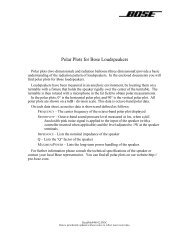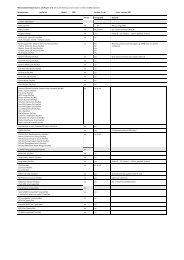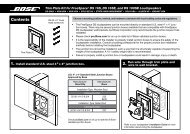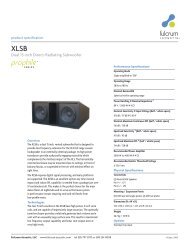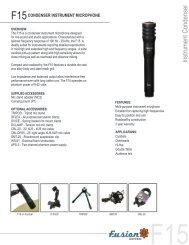ALLEN & HEATH XONE:92 Four-Channel Install Mixer
ALLEN & HEATH XONE:92 Four-Channel Install Mixer
ALLEN & HEATH XONE:92 Four-Channel Install Mixer
You also want an ePaper? Increase the reach of your titles
YUMPU automatically turns print PDFs into web optimized ePapers that Google loves.
T-SCAN >><br />
<strong>ALLEN</strong> & <strong>HEATH</strong> <strong>XONE</strong>:<strong>92</strong><br />
<strong>Four</strong>-<strong>Channel</strong> <strong>Install</strong> <strong>Mixer</strong><br />
EXCLUSIVE!<br />
Words: David Eserin<br />
An extensively enhanced successor to Allen & Heath’s celebrated Xone:62 club mixer, which acts as a MIDI controller to boot.<br />
AT A GLANCE<br />
Price (fader): £1150<br />
Price (rotary): £1300<br />
Web:www.allen-heath.com<br />
Contact:Allen & Heath 0870 755 6250<br />
Available:Mid Feb, but heavily<br />
reserved.<br />
W<br />
ith their brand new Xone:<strong>92</strong>, Allen<br />
& Heath bridge the gap between<br />
the product’s fundamental<br />
purpose as an audio mixer and the provision for<br />
control over tools that create or effect the music -<br />
all by the magic of MIDI. This enables external<br />
effects units such as the Korg Kaoss Pad and<br />
even software to be controlled straight from the<br />
mixer. This sets it apart from any other mixer<br />
available, while quashing any assumptions that<br />
this is just a spruced up Xone:62.<br />
What’s Changed?<br />
The Xone:<strong>92</strong> has been built on continued<br />
research and feedback from users of all the Xone<br />
mixers – top DJs the world over including Richie<br />
Hawtin who played a major role in the<br />
inspiration. The result is a combination of<br />
valuable refinements to the Xone:62, technology<br />
from A&H’s top of the range V6 mixer and a<br />
completely new MIDI concept which is perfectly<br />
suited for advanced DJing and use in live sets.<br />
There are two auxiliary output channels. Two<br />
independent LFOs and filters (with cross-fader<br />
assignment) and the aforementioned MIDI<br />
controllability. The look of the whole mixer is<br />
dramatically different to its predecessors with<br />
attention to detail such as illuminated buttons<br />
and controls. It also has the same sexy VU level<br />
lights, cue buttons and switches found on the<br />
Xone:V6. The new lights are clear and bright,<br />
while not taking up much room on the mixer or<br />
distracting attention. The unit still sits at the<br />
same height and depth as most decks and<br />
simply looks great, especially with a pair of<br />
1200s.<br />
Filters<br />
There are two separate filters, both with high<br />
pass, band pass or low pass settings. Once<br />
selected and activated the frequency is<br />
controlled with a knob on either side of the<br />
cross-fader. The resonance can be increased<br />
from ‘mild’ to ‘wild’, although we thought it<br />
could actually be a little more wild. A&H have >><br />
<strong>92</strong> DJmag
considered the heart conditions of installers here and kept<br />
it tame; it can also be turned off internally for the super<br />
paranoid.<br />
The filters do not have any effect on the signal to either of<br />
the auxiliaries, so when applying external effects and using<br />
a filter at the same time there is no correlation in the two<br />
sounds. The filters cut some of the high frequencies and<br />
low frequencies in their fully open state. However, with the<br />
resonance up half way this flattens out the frequency levels<br />
to normal. One of the greatest things about the filter, apart<br />
from its sound, is that the frequency controls can be joined<br />
together. They can also be assigned individually or paired<br />
to the cross-fader. When controlling both filters using the<br />
frequency knob or cross-fader, one channel can be set to a<br />
hi pass filter and the other to a lo pass filter. On one<br />
complete rotation it creates a unique ability to mix between<br />
tracks using the filters and it sounds wonderfully slick. For<br />
example, in a middle setting one channel will have<br />
everything below 1kHz filtered out, with everything above<br />
1kHz filtered out on the other.<br />
All channels can be set to either filter and can even be<br />
switched from one to the other. By using drastically<br />
different settings on each, the DJ can achieve some pretty<br />
awesome results. There are also two sine wave LFOs (low<br />
frequency oscillators) with a tap tempo feature. The tempo<br />
can be doubled or halved. LFO depth can also be adjusted.<br />
Each filter can even be controlled by the cross-fader with<br />
the LFOs still interacting. >><br />
CHANNEL LAYOUT<br />
Aux Sends<br />
At the top of each channel strip there are volume<br />
controls for each of the stereo auxiliary sends. These<br />
can be set to send the signal regardless of the<br />
channel volume fader level, cross-fader and filter<br />
controls. However, the EQ has an effect over the<br />
auxiliary send regardless of the pre switch. Below<br />
that is the phono and line switch. The gain on the<br />
main channels has a notch in the centre position,<br />
almost urging you to set it at that volume. However, it<br />
seems to provide the perfect signal at its lowest<br />
setting to achieve an average of 0dB. The mic/return<br />
channels simply have the equivalent to a volume<br />
control on a knob<br />
Equalisation<br />
All channels have four-band EQ for Hi, Mid 1, Mid 2<br />
and Lo. On the main channels these all have a<br />
maximum gain of 6dB, which will again please the<br />
installers worried about their precious rig. The DJs<br />
will be happy to see total kills, but only on the Hi and<br />
Lo’s – the two Mids have a drop of -30dB. The actual<br />
separation of the frequencies is much better than on<br />
previous Xone mixers and the extra Mid to the norm<br />
really helps smooth some awkward mixes out.<br />
The EQ on the mic/return channels can be increased<br />
or decreased by 15dB. This gives greater control over<br />
voice and effects which usually require slightly more<br />
attention than vinyl or CD and can also be used to<br />
alter the sound more radically as part of a<br />
performance.<br />
There’s a wide Q (frequency width) for cut and a<br />
narrow Q for boosting, which prevents accumulated<br />
gain. Needless to say they sound great, but it’s a<br />
shame there isn’t the ability to punch the EQ on and<br />
off as on the 62.<br />
Talkover<br />
There’s a switch below the EQ on the mic/return<br />
channels which activates the talkover function; again<br />
this is a three position switch. In the middle the<br />
sound is off, flick it towards you and the channel is on<br />
full. Push the switch back and the channel is on but<br />
the main mix is brought down by 20dB. This enables<br />
perfect control and use of external effects to get a<br />
really pronounced sound above the dry signal. It can<br />
also be used for mic talkover, but there is no<br />
reduction gain control and it’s not automatic, ie. as<br />
the volume of the return or mic changes it does not<br />
automatically reduce the main mix at those times.<br />
Finally, the switch flicks back to the middle position<br />
when released.<br />
Faders<br />
All the faders are incredibly tough while remaining<br />
wonderfully smooth in operation and have new<br />
slimmer knobs attached. The cross-fader has been<br />
upgraded from the 62 with the addition of curve<br />
control. This allows everything from a long, smooth<br />
mix to a very sharp curve for chopping in and<br />
scratching, a facility many DJs had complained was<br />
lacking on previous models. There’s about a 2mm lag<br />
before the sound kicks in on the sharpest setting, but<br />
the action is intuitive and precise.<br />
<strong>Channel</strong> Assign<br />
There are two three-position switches for each channel<br />
(main only), the first sets which filter the channel will be<br />
passed through and the second assigns the channel to<br />
either end of the cross-fader. There’s a set of lights above<br />
the cross-fader that indicate if a channel is assigned, but<br />
it doesn’t signify to which side.<br />
Hidden Features<br />
Levels can be set inside the unit to suit a particular<br />
installation and to avoid damage to any PA<br />
equipment. The unit can also have some ‘ears’ bolted<br />
on the side to mount it in a standard 19in rack space.<br />
The internal settings are described in the manual and<br />
include the ability to reduce the filter resonance and<br />
even turn it off completely. The phono inputs can be<br />
switched to line level. Even the gain can be<br />
deactivated on the main channels. As default the mic<br />
channels are not routed to booth or record, but this<br />
can be changed, but to both only.<br />
Sander Kleinenberg on the Xone:<strong>92</strong><br />
"It's a great and solid looking machine. The new features are a welcome<br />
improvement to the already exceptional sound quality of Allen & Heath’s<br />
mixers. If you look at price, sound and versatility, I would say that this unit<br />
is at the top of the current game.<br />
"I was pretty impressed by the change of how the High, Mid and Low range<br />
is better handled by this mixer. Previous models used to cut a frequency<br />
dead right at the end of the frequency. Now with the new steps it's much<br />
smoother and better to handle.<br />
“However, if there’s one complaint, I talked with the engineer of the mixer<br />
for a while and told him that I would like to see the tab function for the<br />
MIDI clock to be changed to an automated one."<br />
Cue Control<br />
A&H have not only surpassed themselves with great control over cue for each<br />
vital part of the mixer, but managed to inject some humour in there too –<br />
albeit unintentional. The volume knob actually goes up to 11 compared to<br />
every other numbered volume knob which go up to ten - how Spinal Tap. Nice<br />
work! On a more serious and pleasing note, the Xone:<strong>92</strong> has two headphone<br />
outputs (small and large), so you won’t be stuck out if you lose the adaptor.<br />
The output can be set to hear the music before the effect of the cue and after.<br />
Split monitoring changes the master VU meters to display cue and master<br />
separately. Each channel is selected by an illuminated push button. When no<br />
channel is selected for cueing, the main mix is played through the<br />
headphones. The two auxiliary channels can be selected for monitoring and<br />
the cue channel can be blended with the main output to check the mix.<br />
Connections<br />
Each of the four main channels has both line and phono inputs on<br />
RCA. The two auxiliary sends and the returns use jacks. Mic inputs are<br />
XLR only. The master section has two independent Mix outs - one on<br />
XLR and one on jacks with separate volume control. The booth output<br />
is also on jacks and can be muted and even set to mono. There’s also<br />
the standard MIDI output port and a record output on RCA.<br />
DJmag 93
T-SCAN >><strong>ALLEN</strong> & <strong>HEATH</strong> <strong>XONE</strong> <strong>92</strong> CON’T<br />
MIDI Control<br />
The Xone:<strong>92</strong> has a very subtle feature that could<br />
almost be overlooked with just a casual glance,<br />
but its potential control over external devices is<br />
something to be revelled in. The MIDI controls on<br />
the <strong>92</strong> have been designed specifically to work<br />
with the Korg Kaoss pad. All the faders on the<br />
mixer are voltage controlled (VCA), including the<br />
filters (VCF). The faders not only control<br />
components internally but they can also<br />
manipulate virtually any external MIDI gear via<br />
the internal MIDI converter.<br />
A standard MIDI output connector is situated on<br />
the back, so care should be taken to keep the<br />
rear panel accessible if installed into a booth (or<br />
fit a breakout box for convenient access).<br />
In Sync<br />
There are six controls on the Xone:<strong>92</strong> that control<br />
MIDI output. These are the cross-fader, both<br />
filter knobs, the LFO tap button, a start/stop<br />
button and one dedicated MIDI data knob at the<br />
top of the unit. When a tempo is tapped into the<br />
LFO button the <strong>92</strong> instantly starts pumping out a<br />
MIDI Clock. This can be picked up by most effects<br />
units and sequencers that have a MIDI input and<br />
enables timing to be set remotely from the mixer<br />
for delays, chops, etc.<br />
The Data knob is defaulted to act as a fine tuning<br />
tempo controller (also controller 94). Set initially<br />
in the middle (with a dip), turning it to the left<br />
decreases the speed and to the right increases<br />
it. This allows the DJ to hook up a drum machine<br />
The inspiration<br />
for the Xone:<strong>92</strong><br />
Initially, Richie Hawtin<br />
worked with A&H to modify<br />
his Xone:62 – creating his<br />
‘62 CTRL’ which was, in<br />
part, the inspiration for the<br />
Xone:<strong>92</strong>. With invaluable<br />
help from his father<br />
Michael, and cooperation<br />
from A&H designer Andy<br />
Rigby-Jones, Richie built the<br />
most advanced DJ mixer<br />
and live controller in the<br />
world.<br />
Richie: "We changed the mic<br />
channel EQs into the same<br />
ones on the normal<br />
line/phono channels, then<br />
added cross-fader assigns<br />
to all the channels and a<br />
second auxiliary send for<br />
more EFX. Then my father<br />
and I added the second<br />
series of modifications that you can see on the left-hand side of the mixer. We replaced the fader and<br />
EQ knobs with new MIDI control knobs and faders. We added extra buttons and mounted a MIDI<br />
input jack for using a foot controller/switch for further controls. The final assortment of MIDI added<br />
was; six rotary MIDI knobs, six on/off MIDI trigger switches, two toggle on/off MIDI switches (with LED<br />
feedback lights), MIDI fader, MIDI LED activity light and MIDI output jack on the rear of the unit. A few<br />
other things were added, but that was the bulk of it."<br />
and set its tempo straight from the mixer. The<br />
start/stop button uses the standard controller for<br />
all MIDI machines and the stop action also sends<br />
a rewind message to bring the track to the<br />
beginning. This is the only mixer that actually<br />
supports live performance in this way.<br />
Custom Control<br />
The cross fader is set to controller number <strong>92</strong>,<br />
which turns the effects on and off on the Kaoss<br />
Pad. The two frequency knobs on the filters also<br />
control the X and Y of the Kaoss Pad (controller<br />
12 and 13). The Xone:<strong>92</strong> can actually be opened<br />
up to change certain MIDI setting, as described<br />
in the manual. These are modified using little<br />
micro switches.<br />
Remote control<br />
MIDI control can be turned off on the cross fader,<br />
as some will not use this. The global MIDI<br />
channel can also be set to either 15 or 16. And<br />
the data knob can be switched to control effects<br />
depth on the KP2 (controller 95) insted of fine<br />
tunimg the internal MIDI clock. When using a<br />
computer, most software – namely Ableton Live<br />
– can map any controller input number to any<br />
control in the software so the <strong>92</strong> is not limited in<br />
this way. The standard controller numbers set to<br />
each feature on the mixer might not work with<br />
every FX unit, but you can check the<br />
specifications to see which ones match up.<br />
Richie Hawtin<br />
on the Xone:<strong>92</strong><br />
"The <strong>92</strong>, is a huge step<br />
forward in the development of<br />
mixer design. To have a mixer<br />
in production with all its<br />
capabilities is still somewhat<br />
mind blowing. "My 62 CTRL<br />
has 16 controllers, so once<br />
you get used to so much<br />
control and all the<br />
possibilities it’s hard to go<br />
back. But for the rest of the<br />
people out there who don’t<br />
have the luxury of a 62 CTRL<br />
(only two exist), the <strong>92</strong> is not<br />
a step back, its a huge, huge,<br />
huge step forward over the 62<br />
and everything else out there.<br />
"Saying that, I'm waiting for<br />
the <strong>92</strong> CTRL version, which<br />
Andy, my father and I are<br />
currently working on. Ha ha!"<br />
SPECS >>><br />
t Phono: 4 (RCA)<br />
t Line: 4 (RCA) 2 return (Jack)<br />
t Mics: 2 (XLR)<br />
t Master: #1 (XLR), #2 (Jack)<br />
t Booth: Jacks<br />
t Auxiliary: 2 (Jack)<br />
t EQ: 4-band<br />
t 2 Filters: Hi, Lo and Band pass<br />
t 2 LFOs: Freq, Res. and Depth<br />
t LFO tap tempo + MIDI Clock<br />
t Fader options: Rotary/Linear<br />
t Size (mm): 320 x 358 x 83<br />
t Weight: 6kg<br />
good points<br />
MIDI control + Clock<br />
Great sound quality<br />
Two filters and LFOs<br />
Two master outputs<br />
bad points<br />
No BPM recognition<br />
No EQ punch facility<br />
rating<br />
Professional - <strong>Install</strong>ation<br />
value for money<br />
■■■■■<br />
build quality<br />
■■■■■<br />
ease of use<br />
■■■■■<br />
features<br />
■■■■■<br />
sound quality<br />
■■■■■<br />
overall<br />
■■■■■<br />
CONCLUSION<br />
The Xone:<strong>92</strong> is rock solid in both<br />
build and sound quality. The<br />
improvements over the Xone:62<br />
are very valuable, particularly the<br />
new MIDI clock/control which is<br />
a leading concept. The new dual<br />
filters are also very useful - the<br />
first mixer capable of blending<br />
two tracks with two filters using<br />
one knob or cross fader. The<br />
Xone:<strong>92</strong> is the perfect club mixer<br />
for today’s forward thinking DJ.<br />
Many of the features may never<br />
be used by some, but even for<br />
conservative DJs, the filters and<br />
EQ alone add unrivalled polish to<br />
any set.<br />
94 DJmag




